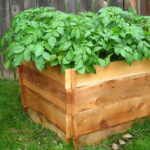Many gardeners don’t have a large space for gardening and continually look for ways to grow their favorite vegetables within these small areas. This guide on how to grow sweet potatoes in containers is for those who want to maximize their available space. We hope that we will help inspire you to plant sweet potatoes, whether it be in a larger container or a raised bed.
Don’t be afraid to plant sweet potatoes among your decorative plants or other vegetables. They have a longer growing season, similar to regular potatoes. Keep in mind, since they are a tuber, the bigger the container, the more sweet potatoes you’ll yield.
Sweet potatoes differ from regular potatoes and true yams, in taste and look. They have reddish skin with a dark reddish/orange interior. Sweet potato tuber skins are softer and have tapered ends. Other potatoes are great to grow, but this guide focuses on the edible, yummy sweet potato – although we also have a great piece on ornamental sweet potato vine, too! Now let’s get started with what you need to do to grow these beauties in a container.
Quick Care Guide
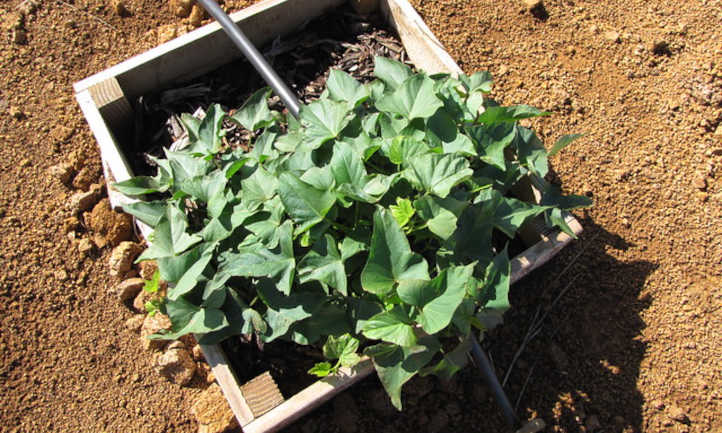
| Common Name(s) | Sweet potato |
| Scientific Name | Ipomoea batatas |
| Days to Harvest | 100-160 days |
| Light | Full sun |
| Water | 1 inch per week |
| Soil | Well-drained sandy loam |
| Fertilizer | Nitrogen, phosphorus, potassium |
| Pests | Sweet potato weevil, flea beetles, cucumber beetles |
| Diseases | Fusarium root and stem rot, powdery mildew |
Container Preparation
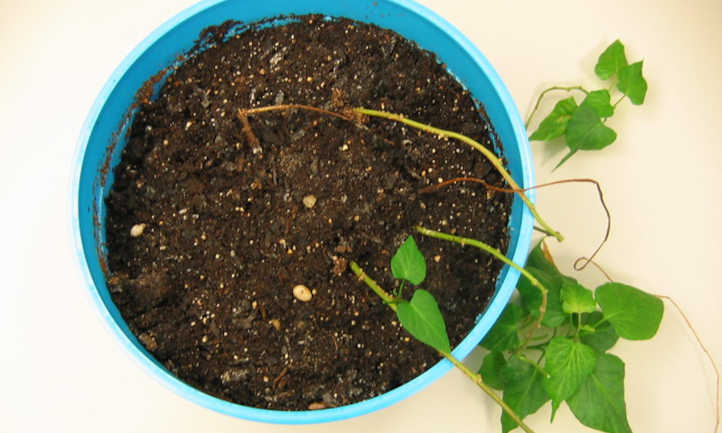
The first step to growing sweet potatoes is to find the right container, which includes the material and the size. Next, use the best possible soil so you can have healthy sweet potato vines that produce edible sweet potatoes.
Size And Material
Sweet potatoes need a large container to spread their vines and develop large tubers. The best containers are at least 20 gallons (though bigger is ultimately better in this case). The type of container you use depends upon how much space you have. Raised beds are an option for a small garden plot or you can use grow bags (we recommend Root Pouch grow bags) on a deck or small patio that easily hold 20-30 gallons. A 20 gallon container provides enough space to plant 4-6 sweet potato slips.
Grow bags offer the most give, allowing for expansion and they also provide airflow and allow adequate water drainage. But wood, plastic, and clay are also popular options. Just make sure the container has four or more holes on the bottom to allow excess water to drain out. If your container is on the deck or patio, place it on a shallow dish to catch the water seeping from the drainage holes. A half wine or whiskey barrel makes an ideal container, and all you need to add are drainage holes. Or, try a 10-gallon Air Pot which can grow 2 to 3 sweet potato slips at a time, and provides expertly-crafted design that supports healthy root systems.
Metal is not a great choice unless you are planting in a raised bed; make sure the bed is at least 8 inches tall to provide plenty of depth for the potatoes. Small metal containers have no give and will often rust before the potatoes fully mature.
Soil Requirements
Sweet potatoes prefer well-drained soil with equal parts sand and loam. This allows the dirt to remain moist, but not overly wet. Potted sweet potatoes will do well with high-quality potting soil amended with compost and sand to help keep the soil light and airy. This allows the potato tubers to grow to an ideal size. Using the correct container will keep the soil mix from becoming too dry or too wet. The same goes for raised beds – use loam sandy soil to fill the beds and amend with compost.
Sourcing And Planting Slips
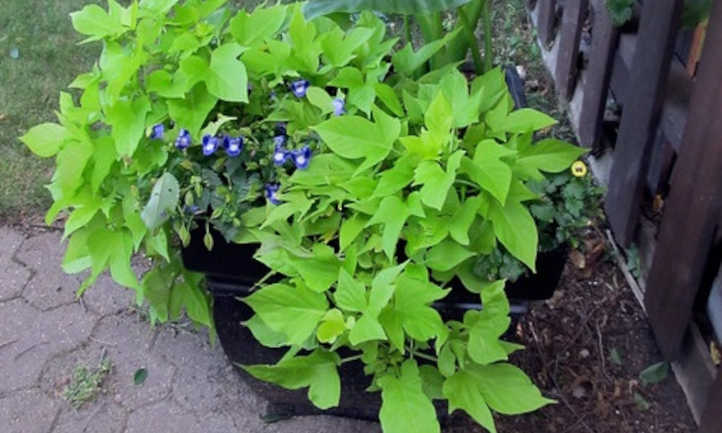
When deciding on the variety of sweet potato to plant, it is important to find one that fits your climate, but also one that is ideal for growing in containers. These varieties offer compact vines, growing more bush-like to keep them smaller. Sweet potatoes can grow from cuttings, but the most popular method for growing sweet potatoes is planting what’s called slips. Basically, a slip is a rooted sprout that has grown from a mature sweet potato. Use healthy (and organic if possible) sweet potatoes for growing slips. Let’s look at growing your own slips, buying them, and then how to plant the slip.
Making A Slip Nursery In Soil
Start slips 8-10 weeks before you plan to plant them outside. This gives them plenty of time for the sprouts to grow about 4 inches and to develop substantial roots for planting. You can usually get 10-15 slips from one sweet potato. Fill a shallow container with moisture-retentive potting mix and nestle the whole potato (lengthwise) into the soil, leaving the entire top exposed.
Place it in a sunny location and keep the soil moist. Once the green growth sprouting is about 4 inches tall (and with plenty of leaves), remove the sprout and plant it directly into your prepared container. Another popular option is to place the sprout in water to root until it is time to plant in its permanent location. It will take 1-2 weeks for the sprouts to form roots. Keep the water fresh while the sprouts root and discard any that don’t appear healthy.
Making A Slip Nursery In Water
Slips are often grown in a jar filled with water, but keep in mind this method produces variable results because the potato can rot quickly when submerged. Mason jars work well because of the shape of the sweet potato. Place one potato in the jar (with the rooting end/tapered end down) and add water so it is only half submerged. The exposed portion will grow the sprouts and the bottom half will form tiny roots. If your potato is too small to stand upright in the jar, poke toothpicks into the sides to help it stand up.
Keep the water nursery in a warm place, (80 degrees Fahrenheit is ideal) that receives plenty of sunlight. Refill with clean water once per week and watch for signs of rot on the potato. You won’t be able to use a potato that rots, so start a few extra just in case. Sprouts should begin forming within one month. Once the sprouts are about four inches, remove from the potato with a sharp knife and either plant in the soil directly or place the sprout in water to form roots before planting. Plenty of roots should form within 1-2 weeks. Freshen the water as needed and discard any slips that aren’t vibrant and healthy.
Buying Slips
If you don’t want to grow your own sweet potato slips, there are many options online to purchase them. Choose a company that provides a money-back guarantee since you are dealing with live plants. Alternately, buy them at your local nursery or garden center in the early spring. An advantage to buying local is they usually sell varieties that grow well in your area. Choose slips that are healthy and thriving.
Planting Slips
You can start planting your slips in your prepared container or raised bed when there is plenty of rudimentary root structure attached. Or if you are planting directly without letting them root in water, dip the ends in rooting hormone to give them a head start. Don’t plant or place your newly rooted sprouts directly outside until the danger of frost has passed and you are experiencing consistently warm days over a few weeks (or temperature soil reaches 50 degrees Fahrenheit).
Plant in loose, yet moist potting soil, burying each slip approximately halfway. Firmly compress the soil around the slip and then water each one well. Space each slip approximately 8 inches apart. This is where well-drained soil is important because the new roots are at risk of root rot if they receive too much water. On average, a 20-gallon bucket will fit 6 slips.
Caring For Your Sweet Potato Planter
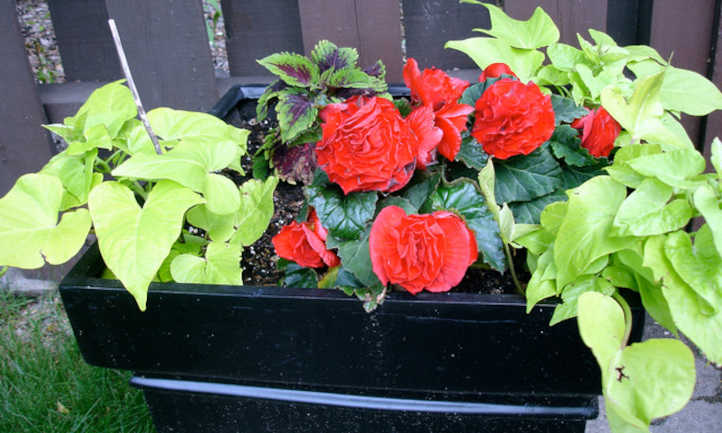
This next section covers the basics of caring for your planted sweet potatoes until it is time to harvest them. As long as you provide the basic essentials, your growing season will yield a good crop. While you can incorporate sweet potato companion plants into larger containers, you may want to opt out in smaller spaces.
Sunlight & Temperature
Sweet potatoes love hot weather and high relative humidity. If it’s not hot enough outside, place your containers in a sunny area indoors and then move them outside to an area that receives 6-8 hours of sun once the weather is warm enough. Avoid placing the containers in shaded areas with the goal of providing at least 6-8 hours of direct sunlight per day. While it is possible to grow sweet potatoes indoors as well, they do love the direct sun!
Watering
Sweet potatoes require at least one inch of water per week. Make adjustments if you planted them in a grow bag or clay pot because the soil will dry quicker. Moist soil keeps your potatoes happy and healthy. Water at the base of the plant to prevent fungal growth on the vines. Also, water as needed throughout the week to keep the soil from drying out.
Fertilizing
If you use good quality potting soil and added compost at the time of planting, you won’t need to fertilize until halfway through the season when the vines are larger. Use a balanced mix of nitrogen, phosphorus, and potassium.
Pruning
Pruning is only necessary if the sweet potato leaves and vines become too large for the container. You can also trim off any leaves that don’t appear healthy. Training and pruning the vines to climb a trellis is an option for sweet potatoes grown in containers.
Harvesting Sweet Potatoes
You’ll know it’s time to harvest sweet potatoes once the vines turn brown and after the first frost. Don’t wait until it gets too cold because the containers don’t protect the potato tuber from freezing.
Dig up each tuber with your hand because using a garden fork can damage the delicate skin. Brush off the excess dirt but do not wash them yet. Place the sweet potatoes in a warm area (approximately 80 degrees Fahrenheit) and let them cure for 10 days. After curing, place them in a ventilated box and store in a cool, dry area.
Troubleshooting
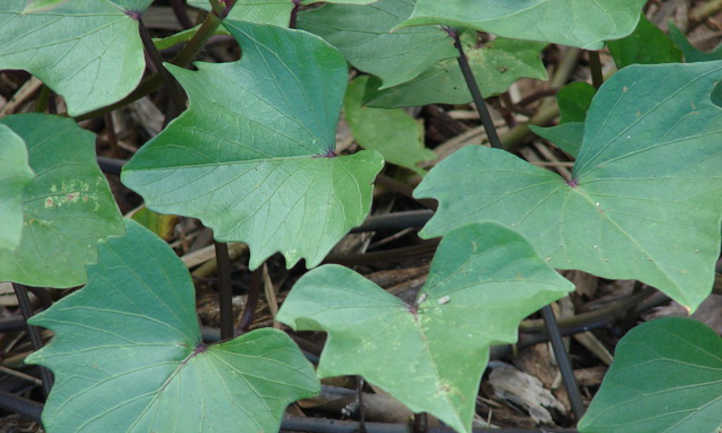
Let’s talk about basic growing problems and a few common pests and diseases to be aware of when growing sweet potatoes.
Growing Problems
Just like other plants, container-grown sweet potatoes can receive too much moisture if there isn’t adequate drainage or the incorrect soil used. Sweet potatoes grow well in full sun and moist soil, but not waterlogged soil. A couple of weeks before it’s time to harvest the firm sweet potatoes, you’ll want to quit watering to prevent the tubers from becoming soft.
Pests
Luckily, sweet potatoes planted in large containers aren’t as susceptible to pests because you have more control over the location and the soil that is used.
One common pest is the sweet potato weevil (Cylas formicarius). It is small with a black body, orange legs, and a long snout. The adults lay eggs in the roots and/or stems of the plant. The larvae feed on the tubers, essentially destroying a crop. Purchase slips and transplants from a reliable source so you don’t accidentally get an infected sprout. Applying certain types of beneficial nematodes to the soil (specifically, the Sc or Hb varieties) can aid in killing off the larvae before they become a severe issue.
Flea beetles may also be an issue. Both spinosad spray and pyrethrin spray can be used to treat a flea beetle outbreak. Cucumber beetles can also cause similar damage and can be treated in the same way.
Diseases
A disease that could affect your container harvest is fusarium root and stem rot (Fusarium solani). This is a fungal disease that infected transplants can spread. Symptoms are circular brown patches on the tubers, yellowing, and dropping of leaves, stunted growth, and death of the plant. It’s difficult to get rid of, so prevention is the key. If you notice green growth turning yellow, or a stunted plant, remove it from the container to prevent the fungus from spreading. Also, only plant slips and transplants that are disease-free. A mycological soil additive may help in reducing the risk to plants.
Powdery mildew is also a risk for sweet potato vines. Avoid watering the foliage of the plant and water at the base. If encountered, remove severely damaged leaves and use either neem oil or copper fungicide to treat the rest of the plant to reduce its spread.
Frequently Asked Questions
Q: How big of a container do I need to grow sweet potatoes?
A: We recommend a 15- 20 gallon container to grow sweet potato plants. The larger the container, the easier it will be for growing edible sweet potatoes. A half whiskey barrel is approximately 16 gallons, and makes a fine choice as a planter.
Q: Can you grow sweet potatoes in 5 gallon buckets?
A: You can, but you won’t get a large harvest – sweet potatoes love plenty of space. If you only have the space for a 5-gallon bucket, you can easily grow 1-2 sweet potato slips. Two slips will yield approximately 10-15 of your own sweet potatoes. When considering how to grow sweet potatoes in containers, keep in mind that the larger the container you have available, the better yield you will be able to get, as these root crops do like extra space to stretch out into!
Q: How long does sweet potato take to grow?
A: On average, a sweet potato tuber is ready to harvest about 100-160 days after planting. Growing sweet potatoes is easy as long as they receive plenty of warm weather with lots of sun and adequate moisture.






